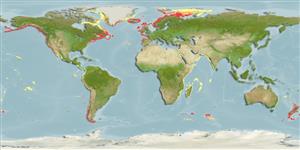Common names from other countries
Classification / Names / Names
Nombres comunes | Sinónimos | Catalog of Fishes (gen., sp.) | ITIS | CoL | WoRMS
Environment: milieu / climate zone / depth range / distribution range
Ecología
; salobre; rango de profundidad 200 - 300 m (Ref. 75621). Tropical
Distribución
Países | Áreas FAO | Ecosistemas | Ocurrencias, apariciones | Introducciones
Arctic, Northeast Atlantic and Indo-Pacific.
Length at first maturity / Tamaño / Peso / Age
Maturity: Lm ? range ? - ? cm Max length : 3.0 cm TL macho / no sexado; (Ref. 75621)
Depth and length based on occurrence record; to be replaced with better reference. Found in estuarine and inshore areas, in substrates of mud, silt, and fine sand (Ref. 96352). Discretely mobile. Known as a suspension feeder (Ref. 75621). A microvore that feeds on organic detritus (Ref. 96352).
Life cycle and mating behavior
Madurez | Reproducción | Puesta | Huevos | Fecundidad | Larva
Members of the class Polychaeta are mostly gonochoric (sexual). Mating: Females produce a pheromone attracting and signalling the males to shed sperm which in turn stimulates females to shed eggs, this behavior is known as swarming. Gametes are spawned through the metanephridia or body wall rupturing (termed as "epitoky", wherein a pelagic, reproductive individual, "epitoke", is formed from a benthic, nonreproductive individual, "atoke"). After fertilization, most eggs become planktonic; although some are retained in the worm tubes or burrowed in jelly masses attached to the tubes (egg brooders). Life Cycle: Eggs develop into trocophore larva, which later metamorph into juvenile stage (body lengthened), and later develop into adults.
López-Jamar, E., G. González and J. Mejuto. 1986. (Ref. 2778)
IUCN Red List Status (Ref. 130435)
CITES status (Ref. 108899)
Not Evaluated
Not Evaluated
Human uses
| FishSource |
Herramientas
Más información
Age/SizeCrecimientoLength-weightLength-lengthMorfologíaLarvaAbundancia
Fuentes de Internet
Estimates based on models
Preferred temperature
(Ref.
115969): 3.8 - 10.1, mean 6.7 (based on 114 cells).
Vulnerability
Low vulnerability (10 of 100).
Price category
Unknown.
